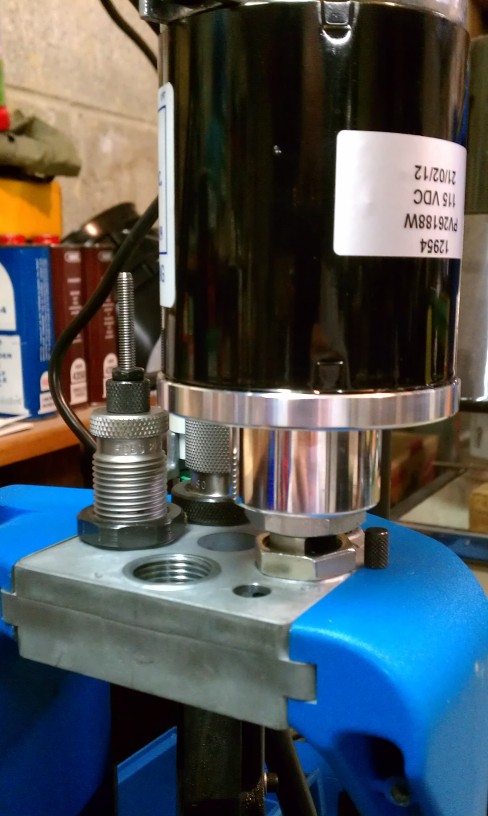I'd like for this to become a How to Guide on using this Dillon Trimmer.
What I have:
1) new Dillon RT 1200
2) .223 die
3) Unique-Tek tool head clamp (added after pics)
4) Dillon XL 650

First thing I noticed when doing the initial set up was deciding what station to place the size/trim die into.
Station 1: FL Resize and decap die
Station 2: Blank
Station 3: Size/Trim Die
Station 4: Blank
Station 5: Lyman M Expander
The Trimmer motor is much larger in diameter than I had envisioned and cannot be placed in Station 2 for two reasons. 1) It hits the FL resizer die and 2) the motor hits the primer feed tube.
I quickly determined that the trimmer motor cannot sit next to any die because it will not fit. The next thing I came to understand is that the trimmer die on the .223 setup has to be set VERY low in the tool head, so low that the lock nut that comes with the die has to be backed up...way up into the cleanout window such that only partial threads are in contact with the die. This is very weak and looks to restrict the size of the clean out window.
Dillon instruction guide says to install the size/trim die into the tool head and run it down until it contacts the shellplate and then back it out 1/2 turn. Be careful not to run the die down to low or this will set the shoulder back too far on your case. Use of a case gage is strongly recommended here.
After the size/trim die is set, size a case and check it for shoulder length, adjust as necessary. Once the correct case length is achieved, tighten the size/trim die lock nut.

At this point I noticed that there was precious little neck sticking out of the trim die into the trim area. I would say .015"-.020" if that. After sizing several pieces of brass and checking this it always seemed about the same. This made me very nervous.... having the carbide cutter run down this close to the die would be real bad. If the carbide cutter made contact with the bottom of the port window in the size/trim die could shatter the cutter and cause serious harm.
With a brass case in the size/trim die lower the handle to run the brass all the way into the die. Screw the trim motor onto the die until the carbide cutter makes contact with the brass. Lower the shell plate and turn the cutter motor down another 1/4 turn. Lock motor jam nut. Keep in mind that the threads are not fine and 1/4 turn down could put you into contact with the die. I have found that there is no way of knowing how close you are to that die with the cutter. Can't see it, can't measure it... you are operating on blind luck here.
I recommend that prior to plugging in the trimmer motor you take a small instrument and attempt to rotate the cutter blade to insure it is not touching anything and is free spinning.
Trim a case and check it with your calipers for total case length. Adjust the motor up or down until the right length is achieved. Lock the motor jam nut. Again, be VERY careful when adjusting down. There is very little room for error on these .223 cases. Not sure about the adjustments for other calibers.
For discussion and further comment consider the following:
1. The motor is not that loud but does generate some vibration that will walk unsecured items right off your bench. Having the tool head clamp kit helps with the toolhead vibrating.
2. With the Trimmer placed in Station 3, there is no way to get the tool head pin or clamp bolt out without unthreading the motor from the die. I find this unacceptable, especially after all the nerve wracking adjustments that had to be made to set the proper trim length.

3. With the Trimmer placed in Station 3 the vacuum assembly has to be cut or trimmed to allow clearance for the tool head pin and/or clamp bolt.
4.This motor is not light, it has some weight to it. Given that die lock nut is backed out so far that only the threads on the sides of the chip exhaust port are contacting, how stable is this set up gonna be over time
5. The Carbide cutter is three sided, if the cutter becomes damaged or dull simply remove from the motor rotate to a new side and reinstall. Walla, like new again. You have three lifes before you need to order a new carbide cutter.
Dillon users, please chime in with your set ups, adjustment suggestions or anything else that relates to the Dillon RT1200.
 Win a FREE Membership!
Win a FREE Membership!